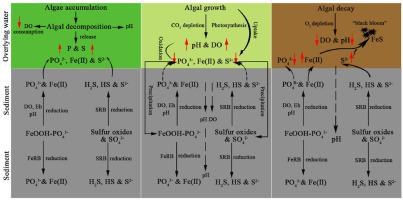Journal of Cleaner Production ( IF 11.1 ) Pub Date : 2021-05-09 , DOI: 10.1016/j.jclepro.2021.127175 Jingzhen Cui , Zengfeng Jin , Yan Wang , Shuaishuai Gao , Zhen Fu , Youwei Yang , Yun Wang

|
Water eutrophication has become a global environmental issue recently. Investigating the chemical gradient, spatial heterogeneity of dissolved oxygen, pH, phosphorus, sulfur, and iron (DO–pH–P–S–Fe) at the water/sediment interface during different algal decomposition stages is critical for exploring the underlying mechanism of the eutrophication process. We conducted mesocosm experiments to observe the two-dimensional distribution imaging in micro-interface using a high-resolution system (e.g., diffusive gradients in thin films and planar optode probes). The process of algal decomposition includes three stages: algal accumulation, algal growth, and algal decay. The changes in the dissolved oxygen (DO) observed in overlying water and upper sediments (−15 mm) and the changes in pH occurred throughout the profile, with their peak values (245.14 μmol L−1 and 10.7) corresponding to the highest chlorophyll-a content (600 mg m−3) and maximum photosynthetic activity, respectively. The distribution of P-S-Fe in overlying water and upper sediments (−20 mm) is mainly affected by the changes in DO and pH caused by algal decomposition, whereas it is mainly affected by microbial activities and other chemical processes in deep sediments. P-S-Fe converged from algae cell and sediments to overlying water during algal accumulation, migrated to sediments in algal growth, and stored in algal decay sediments, while formed “black bloom (FeS)” in overlying water. The findings of this study suggest that light and pH should be controlled during algal accumulation for controlling eutrophication. Moreover, P-S-Fe in overlying water and upper sediments is better to remove in this optimal period, which will contribute a new guideline for the environmental sustainability of water eutrophication caused by cyanobacteria bloom.
中文翻译:

水/沉积物界面藻类分解过程中的富营养化过程机理
近年来,水体富营养化已成为全球性的环境问题。在不同的藻类分解阶段,研究水/沉积物界面中溶解氧,pH,磷,硫和铁的化学梯度,空间异质性(DO–pH–P–S–Fe)对于探索其潜在机理至关重要。富营养化过程。我们进行了介观实验,以使用高分辨率系统(例如,薄膜和平面光电探针中的扩散梯度)观察微界面中的二维分布成像。藻类分解的过程包括三个阶段:藻类积累,藻类生长和藻类腐烂。在上覆水和上层沉积物(−15 mm)中观察到的溶解氧(DO)的变化以及pH的变化在整个剖面中均发生,其峰值(245.14μmolL-1和10.7)对应于最高的叶绿素a含量(600 mg m -3)和最大光合作用活性。PS-Fe在上层水和上层沉积物(-20毫米)中的分布主要受藻类分解引起的DO和pH值变化的影响,而主要受深层沉积物中微生物活动和其他化学过程的影响。PS-Fe在藻类积累期间从藻类细胞和沉积物汇聚到上覆水,在藻类生长过程中迁移到沉积物中,并储存在藻类腐烂沉积物中,而在上覆水中形成“黑花(FeS)”。这项研究的结果表明,在藻类积累过程中应控制光照和pH值,以控制富营养化。此外,在这个最佳时期,上覆水和上层沉积物中的PS-Fe最好去除,



























 京公网安备 11010802027423号
京公网安备 11010802027423号